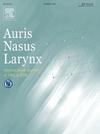饱和明胶泡沫注入鼓膜内类固醇与鼓膜内注射治疗突发性感音神经性听力损失
IF 1.5
4区 医学
Q2 OTORHINOLARYNGOLOGY
引用次数: 0
摘要
目的探讨饱和明胶泡沫(GSD)鼓膜内类固醇(ITS)治疗突发性感音神经性听力损失(SSNHL)的疗效,并与ITS注射治疗进行比较。方法将首次接受ITS治疗且未接受全身类固醇治疗的SSNHL患者分为ITS经注射组(1组)和ITS经GSD组(2组)。比较两组患者的人口学资料、受累侧耳、眩晕耳鸣症状、合并症、开始治疗时间、治疗前后听力水平(HL)、治疗前后单词识别评分(WRS)、听力增益(HG)、WRS增益(WRSG)、康复率(RR)、用药耐受性及并发症。结果治疗前各组shl、WRS评分相近。治疗后听力结果方面,两组间HG、WRSG差异无统计学意义。在RR比较中,2组的评分(70%)显著高于1组(42.4%)(p = 0.028)。在应用的耐受性方面,GSD应用ITS的耐受性明显优于注射ITS (p = 0.046)。并发症方面,2组1例(3.33%)出现鼓膜穿孔,1组1例(3.33%)出现鼓膜穿孔。结论鼓膜内GSD是治疗SSNHL的一种简单、有效、可耐受的技术,其治疗成功率与ITS注射治疗相似,且可显著改善RR评分。本文章由计算机程序翻译,如有差异,请以英文原文为准。
Intratympanic steroid via saturated gelfoam vs. intratympanic injection for sudden sensorineural hearing loss
Objective
The aim of this study was to investigate the efficacy of a novel intratympanic steroid (ITS) therapy via saturated Gelfoam® (GSD) in sudden sensorineural hearing loss (SSNHL) by comparing with ITS injection therapy.
Methods
The patients with SSNHL who received initial ITS therapy with no prior systemic steroid treatment were divided into two groups: the ITS via injection group (Group 1) and the ITS via GSD group (Group 2). The groups were compared in terms of the patients’ demographic data, side of ear involvement, vertigo and tinnitus symptoms, comorbidities, initiation time of therapy, hearing level (HL) before and after therapy, word recognition score (WRS) before and after therapy, hearing gain (HG), WRS gain (WRSG), recovery rate (RR), tolerability of the applications and complications.
Results
HL and WRS scores were similar among the groups before therapy. Regarding the hearing outcomes after therapy HG and WRSG between the groups were not significant. In the comparison of RR, Group 2′s score (70 %) was significantly higher than that of Group 1 (42.4 %) (p = 0.028). In terms of the tolerability of applications, ITS via GSD application was significantly more tolerable than ITS via injection (p = 0.046). Regarding complications, no otorrhea was observed in any patient, and tympanic membrane perforation was observed in 1 patient (3.33 %) in Group 2, whereas no perforation was observed in Group 1.
Conclusion
Intratympanic GSD is a simple, effective and tolerable technique in the therapy of SSNHL, with success rates similar to those of ITS injection therapy and significant improvements in the RR scores.
求助全文
通过发布文献求助,成功后即可免费获取论文全文。
去求助
来源期刊

Auris Nasus Larynx
医学-耳鼻喉科学
CiteScore
3.40
自引率
5.90%
发文量
169
审稿时长
30 days
期刊介绍:
The international journal Auris Nasus Larynx provides the opportunity for rapid, carefully reviewed publications concerning the fundamental and clinical aspects of otorhinolaryngology and related fields. This includes otology, neurotology, bronchoesophagology, laryngology, rhinology, allergology, head and neck medicine and oncologic surgery, maxillofacial and plastic surgery, audiology, speech science.
Original papers, short communications and original case reports can be submitted. Reviews on recent developments are invited regularly and Letters to the Editor commenting on papers or any aspect of Auris Nasus Larynx are welcomed.
Founded in 1973 and previously published by the Society for Promotion of International Otorhinolaryngology, the journal is now the official English-language journal of the Oto-Rhino-Laryngological Society of Japan, Inc. The aim of its new international Editorial Board is to make Auris Nasus Larynx an international forum for high quality research and clinical sciences.
 求助内容:
求助内容: 应助结果提醒方式:
应助结果提醒方式:


